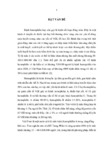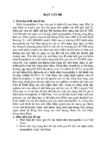
Please use this identifier to cite or link to this item:
http://dulieuso.hmu.edu.vn/handle/hmu/2194| Title: | Nghiên cứu xác định đột biến gen F8 gây bệnh hemophilia A |
| Authors: | Lưu Vũ, Dũng |
| Advisor: | GS.TS Tạ Thành, Văn TS. Trần Vân, Khánh |
| Keywords: | 62720112;Hoá sinh y học |
| Abstract: | ------------------------------------------------. THÔNG TIN TÓM TẮT VỀ NHỮNG KẾT LUẬN MỚI . CỦA LUẬN ÁN TIẾN SĨ. Tên luận án: Nghiên cứu xác định đột biến gen F8 gây bệnh hemophilia A.. Nghiên cứu sinh : Lưu Vũ Dũng . Chuyên ngành : Hóa sinh Khóa: 29 Mã số : 62.72.01.12. Cán bộ hướng dẫn: GS.TS Tạ Thành Văn. TS. Trần Vân Khánh . Cơ sở đào tạo: Trường Đại học Y Hà Nội. Những đóng góp mới của luận án:. Hemophilia A là bệnh di truyền lặn liên quan đến giới tính, gen bệnh nằm trên nhiễm sắc thể X. Người mẹ mang gen bệnh có khả năng truyền bệnh cho 50% con trai của họ, do vậy chủ yếu bệnh nhân là nam. Bệnh đặc trưng bởi thời gian đông máu kéo dài và tăng nguy cơ chảy máu; biểu hiện lâm sàng chủ yếu là xuất huyết, xuất huyết có thể tự nhiên hoặc sau chấn thương nhẹ. Tỷ lệ mắc ở các nước có thể là khác nhau nhưng tần suất chung khoảng 30-100/1.000.000 dân.. Với sự tiến bộ của kỹ thuật sinh học phân tử, hiện nay các nhà khoa học có thể xác định chính xác vị trí đột biến gen yếu tố VIII (F8) gây bệnh hemophilia A, cũng như kiểm soát bệnh tốt hơn nhờ phát hiện người phụ nữ mang gen bệnh và tư vấn di truyền trước hôn nhân, tăng hiệu quả trong việc phòng ngừa bệnh tật đồng thời nâng cao chất lượng chăm sóc sức khỏe trong cộng đồng.. Nghiên cứu này sử dụng 4 kỹ thuật (Inversion PCR, Multiplex PCR, PCR, giải trình tự gen) để xác định đột biến trên 103 bệnh nhân hemophilia A. Kết quả cho thấy đã phát hiện được 89,3% (92/103) bệnh nhân hemophilia A có đột biến gen F8 bao gồm: đột biến đảo đoạn intron 22 là 38,1% (35/92) bệnh nhân, đột biến sai nghĩa là 23,9% (22/92) bệnh nhân, đột biến mất nucleotid là 9,8% (9/92) bệnh nhân, đột biến vô nghĩa là 9,8% (9/92) bệnh nhân, đột biến thêm nucleotid là 9,8% (9/92) bệnh nhân, đột biến tại vị trí nối exon-intron là 4,4% (4/92) bệnh nhân và đột biến mất đoạn lớn là 4,4% (4/92) bệnh nhân. Một đột biến mới chưa công bố đã được phát hiện: p.Gly366insStop. Từ kết quả thu được, bước đầu đã xây dựng được bản đồ đột biến gen F8 trên bệnh nhân hemophilia A Việt Nam.. GIÁO VIÊN HƯỚNG DẪN NGHIÊN CỨU SINH Lưu Vũ Dũng . MINISTRY OF HEALTH THE SOCIALIST REPUBLIC OF VIETNAM. HANOI MEDICAL UNIVERSITY Independence - Freedom - Happiness. -----------------------------------------. NEWS SUMMARY OF CONCLUSIONS NEW. DOCTOR'S THESIS. Name of the thesis: Research in determination of F8 gene mutation cause Hemophilia A. Student reseach: Luu Vu Dung. Major: Biochemistry Course: 29 Code: 62.72.01.12. Supervisors: Prof. Ta Thanh Van. Dr. Tran Van Khanh . Training Facility: Hanoi Medical University. New contributions of the thesis:. Hemophilia A is a recessive sex-linked disease, the gene caused the disease locate in X chromosome. An affected mother can deliver the disease to 50% of her sons, thus, most of the patients are male. The disease is characterized by prolonged blood clotting time and increase risk of bleeding; clinical symptoms mostly are hemorrhage, hemorrhage can be natural or after minor injuries. Incidence rate varies in countries but average rate at about 30-100/1.000.000 people.. With the advance of molecular biotechnology, scientist can determine specifically the location of mutation on Factor VIII (F8) gene caused Hemophilia A, as well as control the disease more effectively thanks to the detection of woman carriers and consultation before marriage, thus, increase the effect of disease control and community health services.. This research used 4 techniques (Inversion PCR, Multiplex PCR, PCR and Gene Sequencing) to determine mutations on 103 Hemophilia A patients. The result showed that 89,3% (92/103) of patients have F8 gene mutation included : 38.1 % of patients (35/92) with intron 22 inversion mutation, 23.9% of patients (22/92) with missense mutation, 9.8% of patients (9/92) with small deletion mutation, 9.8% of patients (9/92) with nonsense mutation, 9.8% of patients (9/92) with insertion deletion, 4.4% of patients (4/92) with splicing site mutation and 4.4% of patients (4/92) with large deletion mutation. A mutation has not been published was found: p.Gly366insStop. According to the achieved result, the research have initially constructed F8 gene mutation map of Hemophilia A patients in Vietnam.. SCIENTIFIC GUIDANCE STUDENT RESEARCH. THÔNG TIN TÓM TẮT VỀ NHỮNG KẾT LUẬN MỚI. CỦA LUẬN ÁN TIẾN SĨ. Những đóng góp mới của luận án:. Hemophilia A là bệnh di truyền lặn liên quan đến giới tính, gen bệnh nằm trên nhiễm sắc thể X. Người mẹ mang gen bệnh có khả năng truyền bệnh cho 50% con trai của họ, do vậy chủ yếu bệnh nhân là nam. Bệnh đặc trưng bởi thời gian đông máu kéo dài và tăng nguy cơ chảy máu; biểu hiện lâm sàng chủ yếu là xuất huyết, xuất huyết có thể tự nhiên hoặc sau chấn thương nhẹ. Tỷ lệ mắc ở các nước có thể là khác nhau nhưng tần suất chung khoảng 30-100/1.000.000 dân.. Với sự tiến bộ của kỹ thuật sinh học phân tử, hiện nay các nhà khoa học có thể xác định chính xác vị trí đột biến gen yếu tố VIII (F8) gây bệnh hemophilia A, cũng như kiểm soát bệnh tốt hơn nhờ phát hiện người phụ nữ mang gen bệnh và tư vấn di truyền trước hôn nhân, tăng hiệu quả trong việc phòng ngừa bệnh tật đồng thời nâng cao chất lượng chăm sóc sức khỏe trong cộng đồng.. Nghiên cứu này sử dụng 4 kỹ thuật (Inversion PCR, Multiplex PCR, PCR, giải trình tự gen) để xác định đột biến trên 103 bệnh nhân hemophilia A. Kết quả cho thấy đã phát hiện được 89,3% (92/103) bệnh nhân hemophilia A có đột biến gen F8 bao gồm: đột biến đảo đoạn intron 22 là 38,1% (35/92) bệnh nhân, đột biến sai nghĩa là 23,9% (22/92) bệnh nhân, đột biến mất nucleotid là 9,8% (9/92) bệnh nhân, đột biến vô nghĩa là 9,8% (9/92) bệnh nhân, đột biến thêm nucleotid là 9,8% (9/92) bệnh nhân, đột biến tại vị trí nối exon-intron là 4,4% (4/92) bệnh nhân và đột biến mất đoạn lớn là 4,4% (4/92) bệnh nhân. Một đột biến mới chưa công bố đã được phát hiện: p.Gly366insStop. Từ kết quả thu được, bước đầu đã xây dựng được bản đồ đột biến gen F8 trên bệnh nhân hemophilia A Việt Nam.. NEWS SUMMARY OF CONCLUSIONS NEW. DOCTOR'S THESIS. New contributions of the thesis:. Hemophilia A is a recessive sex-linked disease, the gene caused the disease locate in X chromosome. An affected mother can deliver the disease to 50% of her sons, thus, most of the patients are male. The disease is characterized by prolonged blood clotting time and increase risk of bleeding; clinical symptoms mostly are hemorrhage, hemorrhage can be natural or after minor injuries. Incidence rate varies in countries but average rate at about 30-100/1.000.000 people.. With the advance of molecular biotechnology, scientist can determine specifically the location of mutation on Factor VIII (F8) gene caused Hemophilia A, as well as control the disease more effectively thanks to the detection of woman carriers and consultation before marriage, thus, increase the effect of disease control and community health services.. This research used 4 techniques (Inversion PCR, Multiplex PCR, PCR and Gene Sequencing) to determine mutations on 103 Hemophilia A patients. The result showed that 89,3% (92/103) of patients have F8 gene mutation included : 38.1 % of patients (35/92) with intron 22 inversion mutation, 23.9% of patients (22/92) with missense mutation, 9.8% of patients (9/92) with small deletion mutation, 9.8% of patients (9/92) with nonsense mutation, 9.8% of patients (9/92) with insertion deletion, 4.4% of patients (4/92) with splicing site mutation and 4.4% of patients (4/92) with large deletion mutation. A mutation has not been published was found: p.Gly366insStop. According to the achieved result, the research have initially constructed F8 gene mutation map of Hemophilia A patients in Vietnam.. |
| URI: | http://dulieuso.hmu.edu.vn//handle/hmu/2194 |
| Appears in Collections: | Luận án (nghiên cứu sinh) |
Files in This Item:
| File | Description | Size | Format | |
|---|---|---|---|---|
| 88_La- Dung HS.pdf Restricted Access | 4.09 MB | Adobe PDF |  Sign in to read | |
| 88_24 -Dung HS.pdf Restricted Access | 2.2 MB | Adobe PDF |  Sign in to read |
Items in DSpace are protected by copyright, with all rights reserved, unless otherwise indicated.